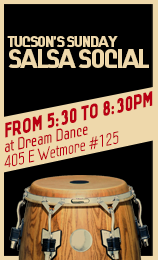The Story Behind the Mambo N.Y. Style On 2
Of African and European parentage, the mambo is the result of a long cross-cultural journey, an example of the kind of sensual alchemy which is a specialty of the Caribbean. Mambo, conga and bongo were originally Bantu names for musical instruments that were used in rituals and gradually became secular. Mambo means "conversation with the gods" and in Cuba designates a sacred song of the Congos, Cubans of Bantu origin. The Congos have absorbed a variety of foreign influences and the mambo is a delicious cocktail of Bantu, Spanish and Yoruba.
Despite its African resonance, the mambo can be traced back to an unexpected source, English country dance, which in the seventeenth century became the contredanse at the French court and later the contradanza in Spain. In the eighteenth century the contradanza reached Cuba where it was known as danza and became the national dance. Its hold grew with the arrival of the planters and their slaves who fled from Haiti after it became independent. The Haitian blacks added a particularly spicy syncopation to it called the cinquillo, which is also found in the tango, itself derived from the contradanza. Gradually other black elements found their way into the contradanza, some titles of which--such as "Tu madre es conga" ("Your mother is Congo"), which was played in 1856 in Santiago de Cuba at an aristocratic ball in honour of General Concha, and "La negrita"--reflect this blending.
A New Kind Of Music
At the end of the nineteenth century the contradanza threw off its European yoke, and freer, more spontaneous dancing by couples replaced the starchy formality of the contredanse. This new kind of music was known as danzon. In 1877 it had a huge success largely due to pieces such as "Las alturas de Simpson" by a young musician from Matanzas, Miguel Failde. The danzon had several sections, one of which was a lively coda which musicians soon got in the habit of improvising. It was played by brass bands or tipicas, which gave way in the 1920s to lighter combos known as charangas, which featured violins, sometimes a cello, a piano, a guiro (a grooved calabash scraped with a comb), a clarinet, a flute, a bass and double drums adapted from European military drums.
Charangas, notably that of the flautist Antonio Arcano, flourished in the late 1930's. In 1938, Arcano's cellist, Orestes Lopez, composed a danzon he called "Mambo," and in the coda Arcano introduced elements from the son, a lively musical genre from Cuba's Oriente province. As a signal to band members that they could start their solos, Arcano would call out, "Mil veces mambo!" ("A thousand times mambo!"). Today, in the Latin American music known as salsa, the mambo is a theme that is played in unison by the rhythm section and serves as a transition between two improvised passages.
Arcano was a talented musician, but it was his countryman Pérez Prado who was the first to market his compositions under the name "mambo," which he popularized as a specific musical genre. He used jazzier instruments, including brass and drums. Early in the 1950's his mambos "Patricia" and "Mambo No. 5" took Latin America and the United States by storm.
The Temple Of Mambo
By the mid-1950's mambo mania had reached fever pitch. In New York the mambo was played in a high-strung, sophisticated way that had the Palladium Ballroom, the famous Broadway dance-hall, jumping. The Ballroom soon proclaimed itself the "temple of mambo," for the city's best dancers--the Mambo Aces, "Killer Joe" Piro, Paulito and Lilon, Louie Maquina and Cuban Pete--gave mambo demonstrations there and made a reputation for their expressive use of arms, legs, head and hands. There was fierce rivalry between bands. The bands of Machito, Tito Puente, Tito Rodriguez and Jose Curbelo delighted habitues such as Duke Ellington, Bob Hope, Marlon Brando, Lena Horne and Dizzy Gillespie, not to mention Afro-Americans, Puerto Ricans, Cubans, Upper East-Side WASPs and Jews and Italians from Brooklyn. Class and color melted away in the incandescent rhythm of the music. Even jazz musicians such as Erroll Garner, Charlie Parker, Sonny Rollins and Sonny Stitt fell under the mambo's charm, as can be heard on the many Latin recordings they made in the 1950's.
In 1954 the cha-cha-cha, a kind of mambo created by the Cuban violinist Enriqué Jorrin, a member of the Orquesta America Charanga, swept through Havana and New York. Easier to dance than the mambo, with a squarish beat and a characteristic hiccup on the third beat, it spread to Europe, before being dethroned in the early 1960's by the pachanga and then the boogaloo.
Since the mambo there has never been a dance that has given rise to so much unbridled fantasy and pyrotechnics or reached such rhythmic rapture. Today it is making a comeback and bringing a glimmer of paradise regained as the world again moves to its magical beat.
"MAMBO, qué rico el mambo!"
In the post-war years the mambo was a euphoric and voluptuous celebration of the long-awaited return of freedom. Many will remember the great Italian actress Silvana Mangano dancing the mambo in the marvellous film of the same name.
by Isabelle Leymarie







